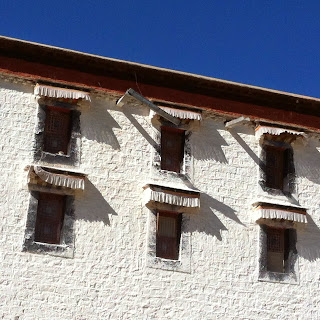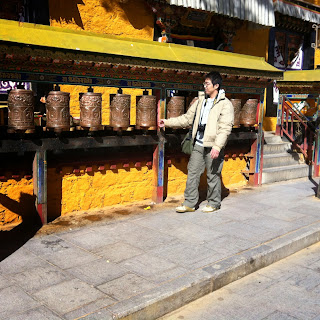I
have gotten quite interested in Tibet. According to Wikipedia, 5.4
million Tibetans lived in this country in 2008, with another 189,000
of them dispersed in other countries. Chinese statistics say that
improvements in Tibetan health per 100,000 population are large
between 1951 and 2010: women's maternal death rate, from 5,000 to
175; infant mortality, 430 to 21; life expectancy, 35.3 to 67. I
have a hard time believing these numbers because I think a
substantial portion of the population remains rural or nomadic, and
many of the websites on Tibet are blocked from here. I did find out
that Tibet is only about one-eighth the size of the United States,
and it contains 800 of what are called “settlements” –
villages, towns or cities. Because life here is so harsh, people do
not live isolated from each other. Nevertheless, because so much of
the land is uninhabitable – the Himalayas are in the northern part
of the country – the population density is only 2 people per square
mile. I once read a book about what life was like in the United
States with population density that low, and it was very distorted
compared to my experience. I can only imagine what it must be like
here with the cold and the snow.
Lhasa
itself is only the second-largest city, “liberated” in 1951 and
appointed the capital of the Tibetan Special Autonomous Region as of
1965.
Before
birth control was introduced in Tibet, people necessarily had many
children. A form of poverty avoidance as well as population control
was to give two or three of your sons to the monastery, which
moreover was the only place to get an education. Children entered
the monastery as young as seven and were not allowed to leave the
monastic life regardless of their feelings about it, until they were
25 or older. Naturally monks were celibate, and supported by
donations from their families and other pious families. There were
and are nunneries too but they are less numerous and less important
in the society, where boys are still prized over girls. It was only
with the Chinese arrival that families were encouraged to value
girls, ironically enough given the traditional Chinese attitude about
girls. However there is still great inequality, as many parents
still believe it is useless to educate girls because all they need to
know is how to cook, care for children, and make handcrafts to sell.
Currently many families prefer to have only two children in order to
be able to afford such things as appliances, vehicles, and cell
phones.
Now
to get a government job one must graduate from Tibet University.
There is an entrance exam and it costs to attend, but if very poor
children pass the exam the government will pay for them to attend.
People with government jobs, such as teachers, earn about 5,500 yuan
per month in Lhasa, about $917, and private shopkeepers earn an
average of 3,000 yuan per month – a good demonstration of the power
the government holds to bestow blessings. There has been
considerable inflation in Lhasa lately, causing poor people much
difficulty.
In
the morning we went to the Potala Palace. We have all seen pictures
of it but I cannot tell you how massive it is. It is built on the
highest hill in a relatively flat plateau. I took this picture in
the late afternoon, obviously from a place much higher than Lhasa,
but you can see the plateau better. Look carefully:
in the right rear you can see the palace.
The
palace from close up looks like it measures a kilometer from side to
side but perhaps it is less. It was started in the 7th
century by the famous 5th Dalai Lama, and was gradually
added to over the years. This explains the asymmetry.
The
stairs went up 150 meters, so I decided that a good thing for me to
do was to sit in the sunshine at the bottom and meditate while half
the group climbed to the top. It was a lovely way to spend a couple
of hours.
Every
year the palace is whitewashed in the fall – before the Tibetan New
Year in January or February and before it gets too cold. Volunteers
climb up with what looks like two-gallon cans of whitewash strapped
to their backs and toss it onto the walls. You can see the whitewash
splattered on the window surrounds.
The
people-watching was superb. I couldn't take enough pictures of these
lovely people. Children:
Women
carrying a prayer wheel and prayer beads, and a picture of prayer wheels for sale at the bazaar.
There are
prayer wheels you carry and other stationary wheels you spin as you
walk past.
Devout
Buddhists circumambulated around it clockwise, as much or as little
as they had devotion, time, and/or energy for. Some walk around it
all day. I saw two men making the passage by throwing themselves on
the ground and sliding their hands forward on small wooden platforms
with fabric above to put their hands into. At the end of the
prostration they got to their knees and then their feet and then
stood up, walking a step or two before repeating the process.
At
this shrine some men and women stopped, took off their hats, bowed,
and continued on. I saw a man take a piece of paper money out of the
shrine on the right and put it into his hat. Maybe it was only
change??
Watching
all these devotion rites underlined for me how arbitrary they are.
Almost anything can be dreamed up to signify that the deity likes it,
so people repeat it and repeat it and repeat it.
These
two women with small children on their back stopped so the one in the
back could change the diaper of the one in the front.
In
the park there were many uplifting signs, including this one about
the duties the generations owe each other.
The
weather is definitely fall, with the leaves from the trees falling
onto the shorter pines below. I thought this was beautiful.
After
lunch – yak curry stew! – we went to two monasteries high up in
the mountains above Lhasa, where it was even more difficult to
breathe. I should know better than to say I am glad to skip
anything: it was fascinating. This monastery made wood-blocks –
the same long shape as I'd seen in the museum – and sold copies of
the holy books in this shape and also printed as modern perfect-bound
books. Outside one of the temples I saw people prostrating
themselves on body-length cushions with their hands placed on wooden
things to slide forward along the pavement at each prostration.
Parents
bring children here to be blessed, as indicated by a black mark on
the nose. Interestingly to me, many of the parents were fathers.
If
you want to be a real hermit, you could live here.
These
women were sitting and resting outside the front gate of the
monastery.
The
monks in the pictures below were all students debating questions
about Buddhism. They take turns being the questioner (those who are
standing), and the person answering (those who are sitting on
cushions on the pebbled ground). It was astonishingly noisy. The
questioner asked his questions while lifting up his left leg and
smacking it down again while he clapped his hands together stingingly
hard and loud. The questions and answers were also very
loud. When a student did not answer well the teacher smacked him on
the head. I imagine tomorrow when it's his turn the student will
have his revenge.
In
this village we were able to see yaks from close up – or, for all I
know, a yak/cow blend. My yak expertise is pretty shaky.
There
are five levels of what happens to people when they die, according to
the level of virtue they displayed in their lives. This is
supposedly decided by their families, and there are sometimes
(often?) differences of opinion. The first level is for lamas, who
are cremated and their ashes are placed in elaborate structures in
temples along with a picture of them. The second level is sky
burial, in which the body is chopped in small pieces and eaten in an
hour by vultures, which are honored animals because they do not kill
anything living. The third level is water burial, where the body is
chopped into small pieces to be eaten by fish. The fourth level is
fire burial, well, really cremation, like suttee in India. And the
fifth and lowest level for bad people is earth burial, not favored
because it poisons the earth.
The
second monastery we went to was for the purpose of sky burials.
Non-Tibetan Buddhists are not allowed to see the place this happens.
It is behind the white building to the right of the picture.

This
hillside was decorated with Tibetan prayer flags.
We
went into a meditation and prayer room that was a cave lit by a large
bowl where wicks burned yak butter oil.
Touching
the cave ceiling, my fingers came away with soot from burning yak
butter oil for so many years.
Another
kind of fuel is dried yak dung.

It
is not necessary to go to deepest Africa or South America to study
societies in transition. It is so clear right here in Lhasa, where
so many people wear traditional clothes and others wear platform
heels. And everything in between. For me this next picture sums up
the changing social standards so well. I took it in the sky burial
monastery.
For
dinner, at my request, those of us who wanted could have yak steak.
Most of the group chose yak burgers instead and then carefully
removed the lettuce, tomato and onion as unsafe to eat. Yak is lean
meat so it was marinated beforehand, and absolutely delicious. I am
thrilled to have been able to taste it.
This
is a tiring trip, no question. People who have been on several or
many Overseas Adventure Travel trips say that there is less down time
on this one than on any others, one place to the next to the next.
I'd say it's quantity over quality but my eyes are marveling at
everything I am seeing, even the trash on the ground here, even an
old chair tossed into a canal, unlike China where everything is so
clean.



























No comments:
Post a Comment